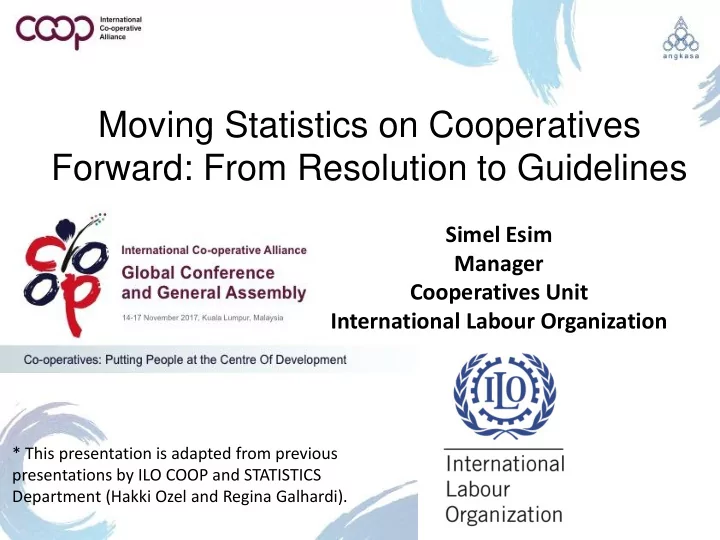

Moving Statistics on Cooperatives Forward: From Resolution to Guidelines Simel Esim Manager Cooperatives Unit International Labour Organization * This presentation is adapted from previous presentations by ILO COOP and STATISTICS Department (Hakki Ozel and Regina Galhardi).
Contents International Statistical System National and International Statistical System International Standards on Labour Statistics International Conference of Labour Statistics 19th ICLS Resolution on Cooperative Statistics ILO Follow up to the Resolution ILO Global mapping ILO Country case studies (+ 2 FAO case studies) ILO Conceptual framework ILO Background studies (employment, value added) COPAC Technical Working Group on Statistics of Cooperatives COPAC background study on classification 20th ICLS Guidelines on Statistics of Cooperatives
1. Labour statistics standards in the 1. International Statistical System International Statistical System UN Statistical Commission ILO -Labour UNCTAD -Trade UIS -Education UNWTO -Tourism Committee for the coordination of statistical activities WHO -Health WMO -Climate (CCSA) ITU FAO -Agriculture Telecommunications OTHER OTHER
National & International Statistical Systems International Statistical System UNSD ILO –ICLS UNESCO UNCTAD WHO … National Statistical System NSO Ministry of Labour Ministry of Education Ministry of Health Central Bank …
International Standards on Labour Statistics 1. Conventions and Recommendations adopted by the International Labour Conference (ILC) Part of International labour code Conventions: Legally binding in ratifying countries Convention No. 160 adopted in 1985 (replaced C 63) Sets minimum guidelines on all areas of basic labour statistics Recommendations: Non-binding Recommendation No. 170 adopted in 1985 Provides further guidance regarding frequency of data collection, recommended statistics, and national statistical infrastructures 2. Resolutions and Guidelines adopted by the International Conference of Labour Statisticians (ICLS) Resolutions: Set standards on conceptual frameworks, operational definitions and measurement methodologies (Non-binding) Guidelines: Provide guidance on very specific topic areas (Non-binding)
2. International Conference of Labour Statisticians • Purpose – Statistical standard-setting mechanism of the ILO • Tripartite structure – Governments, employers’ and workers’ representatives • Meeting – Every 5 years (since 1923) • Participation – Expert statisticians from governments (NSO, MoL) and from employers’ and workers’ organizations – Observers: Regional & international organizations
Outcome of the 19th ICLS A Resolution concerning further work on statistics of cooperatives was adopted It recommends to improve national statistics related to the number and characteristics of cooperatives, members of cooperatives, workers employed in cooperatives and the value added of cooperatives. According to the resolution, the ILO should carry out: • (i) further developmental work on measurement of cooperatives through administrative registers, establishment or household surveys; • (ii) pilot studies in interested countries, and prepare a progress report for discussion at the 20th ICLS in 2018
Follow up 1: Global Mapping Report ILO set up an initiative which aims at advancing the implementation of the 19 th ICLS Resolution and to prepare for the 20 th ICLS with progress report A global mapping effort was launched to develop an “ inventory ” of existing data on cooperatives gathered by NSOs and other providers and/or producers Analytical report on the information available (providers, sources, variables) at the national level and according to regions • Regional/subregional patterns according to sources & providers • Good Practices or “improved practices” • Next steps to be undertaken (more in-depth country case studies)
Follow up 2: ILO Country Case Studies Country case studies were developed to analyze country data collection methodologies, processes, instruments and definitions in order to develop proposals toward standard definitions and collection methods on cooperatives First set of countries Second set of countries FAO Country case studies (Oct 2015 - Feb 2016) (Sep – Dec 2016) • Ethiopia • Russian Federation • Spain • Vietnam • Colombia • Italy • Canada • France • Brazil • South Korea • the United Kingdom • Costa Rica • the Philippines
COPAC Technical Working Group (TWG) on Statistics of Cooperatives COPAC (Committee for the Promotion and Advancement of Cooperatives - ILO, FAO, UN DESA, ICA and WFO) identified cooperative statistics as a priority Multi-stakeholder workshop on statistics on cooperatives (May 2016): Common understanding and agreement for developing a statistical system on cooperatives (30 coop movement, NSOs, policy makers & researchers) COPAC Technical Working Group on Statistics on Cooperatives: A working group of users & producers of statistics (Oct 2016 – Dec 2018): (i) Review statistical definitions relevant to identification and classification of cooperatives, in advance of the 20 th ICLS in 2018; and (ii) Develop recommendations to build the capacities of stakeholders on collecting data and producing statistics on cooperatives
Follow up 3: Conceptual Framework • Conceptual Framework for the Purpose of Measurement of Cooperatives and its Operationalization • Discussed at the COPAC TWG meeting in May (by M. Bouchard, M. Le Guernic and D. Rousselière for the ILO) • Presents a general overview of how cooperatives and key concepts are measured for statistical purposes • Reviews key statistical studies on cooperatives • Identifies conceptual & methodological issues on identification & classification of cooperatives & discusses core components & boundary areas • Proposes a conceptual framework for defining and classifying cooperatives for measurement
Follow up 4: Three background papers • Cooperative employment measurement (categories, variables & methods): Propose a statistical conceptualization of the different employment forms in cooperatives as input into guidelines on statistics of cooperatives • Economic contributions of cooperatives: Explore alternatives measures of wealth created by cooperatives (e.g., social accounting, social matrix, impact analysis, input-output analysis) • A classification tool for cooperatives: Elaborate a meta-typology of categories or types of cooperatives according to cooperative characteristics
GUIDELINES ON STATISTICS OF COOPERATIVES • Develops operational guidelines based on existing standards (Conventions, Resolutions, Guidelines) • Reviews existing international standards and national practices on data- collection on cooperatives • Incorporates the background papers on the measurement of employment/work, the measurement of value added and classification • Presented and discussed at the COPAC TWG meeting March/April 2018 • Presented at the 20th International Conference of Labour Statisticians in October 2018 in Geneva for consideration by National Statistics Offices
THANK YOU coop@ilo.org esim@ilo.org
Recommend
More recommend